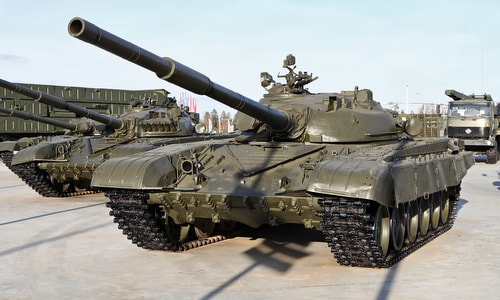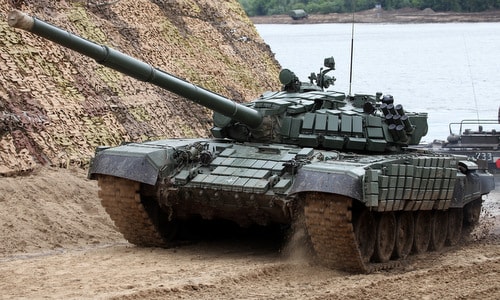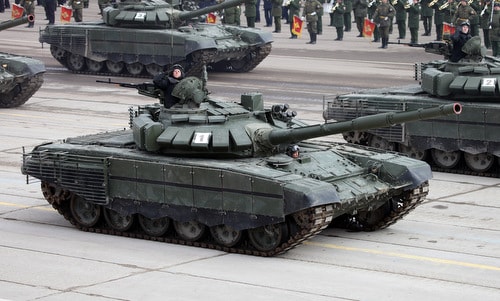Solution to help Russia turn old T-72 tanks into modern 'killers'
A series of defense and firepower upgrade packages help strengthen the aging T-72 tank, ensuring its combat capability in the 21st century.
 |
The first version of the T-72 was not equipped with explosive reactive armor. Photo: Vitaly Kuzmin |
The high cost of the T-14 Armata main battle tank and the limited defense budget make it difficult for the Russian military to deploy thousands of these tanks in the coming years. That forces the Russian Ministry of Defense to modernize older equipment such as the T-72 tank, to ensure their combat capability in modern combat environments until there are enough new weapons to replace them, according to National Interest.
The Russian Army currently has 2,700 main battle tanks (MBTs) of various types in combat readiness, including 1,900 T-72B tanks of various types, along with 450 T-80s and 350 T-90As. In addition, Moscow is also storing about 7,000 T-72 tanks, making them the backbone of Russia's armored forces.
When it first appeared in 1973,The T-72 is considered a fearsome weapon on the battlefield. Compact in size, equipped with composite armor and a completely new 125 mm smoothbore gun, the T-72 series is a major breakthrough compared to the T-62 model.
The autoloader helped reduce the turret size, even though the 2A46M gun and 125mm ammunition on the T-72 were larger than on previous tanks, and cut the crew to just three. The 780-horsepower engine gave the first version of the T-72 a top speed of 60 km/h on asphalt.
The T-72 is equipped with armor that is superior to the main battle tanks of the same period of the US and NATO. Composite armor, combining steel and fiberglass, gives the front of the T-72 the ability to protect equivalent to 450 mm of rolled homogeneous steel (RHA). The T-72B1 version is equipped with additional front armor, increasing the ability to withstand Western armor-piercing shells by 50%.
The Kontakt-1 explosive reactive armor (ERA) doubled the T-72's resistance to high-explosive anti-tank (HEAT) rounds. By the mid-1980s, the Kontakt-5 version was released, allowing the T-72 to maintain its combat capability against the most advanced American anti-tank missiles of the time, such as the TOW.
 |
T-72B1 model with ERA protection blocks around. Photo: Vitaly Kuzmin. |
The T-72 served as the mainstay of the Soviet mechanized infantry throughout the Cold War, and was exported to many countries, including Syria and Iraq. However, they were easily destroyed in conflicts in the Middle East, mainly due to poor training and poor command. Some weaknesses of the export T-72 variant were also shown, such as ammunition with half the penetration capacity of the Soviet T-72, poor fire control and night vision systems, and lack of composite armor and ERA.
The economic crisis in Russia after the collapse of the Soviet Union forced the country to cut its defense budget and cancel many new generation tank projects. That made the T-72 still play the role of backbone of the Russian army, and at the same time applied many upgrade packages such as new HEAT ammunition and anti-tank missiles.
Improved economic conditions in the 2000s allowed Moscow to finance military modernization projects. The most modern T-72B3 version was introduced in 2010 with the aim of improving the combat capabilities of the aging T-72B vehicles.
This upgrade package provides a completely new Kalina fire control system and ballistic computer. The gunner can aim at longer ranges and more accurately thanks to the multi-channel sighting system, while protection is enhanced by Kontakt-5 ERA pods arranged in the configuration of the T-90A tank.
In early April this year, the Russian military first revealed the upgraded T-72B3 model at the Victory Day parade rehearsal. This version is equipped with many new defense systems, taken from the T-90A and T-90MS tanks.
The most prominent feature is the Kaktus explosive reactive armor blocks installed on both sides of the rear of the turret, replacing the tank's spare parts storage boxes. The rear of the turret, the rear of the vehicle and both sides of the engine are all fitted with cage armor, helping to block HEAT bullets more effectively. The front of the hull is fitted with a Relikt explosive reactive armor module similar to the T-90MS model.
 |
The modernized T-72B3 version was launched by Russia in the middle of this year. Photo: Vitaly Kuzmin. |
The side of the vehicle is also covered with a new steel-rubber armor, capable of detonating HEAT warheads before they hit the main armor. The undercarriage is adjusted to increase mine resistance compared to older T-72 versions.
The offensive capabilities of this T-72B3 version have also been significantly improved, including the installation of the Sosna-U fire control system with thermal imaging glasses of the T-90MS. This system allows the T-72B3 to fight day and night, in all weather conditions. Sosna-U also gives this model hunter-killer capabilities. The commander can search and turn the gun towards the target, the gunner only needs to adjust the precise aiming line and fire. Meanwhile, the commander continues to detect new targets.
The vehicle uses the 2A46M5-01 main gun, allowing it to launch modern anti-tank missiles such as the 9M119 Svir, 9M119M Refleks and many new generation kinetic energy ammunition. The previous T-72 series used an old gun and automatic loading system, unable to fire new ammunition designed by Russia.
The Russian tank force will likely use the T-14 Armata and T-80U in the role of spearhead, while the T-90A and T-72B3 will accompany the mechanized infantry formation behind. That makes the modernized T-72 still have an important role on the future battlefield, at least until Moscow is able to replace the entire force with new tanks, expert Kyle Mizokami said.
According to VNE
| RELATED NEWS |
|---|


.png)

